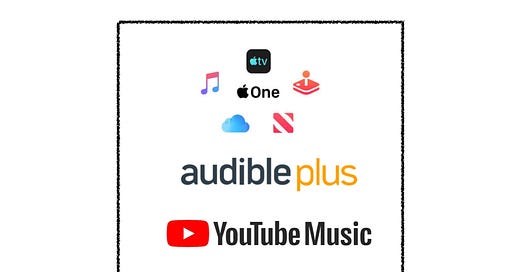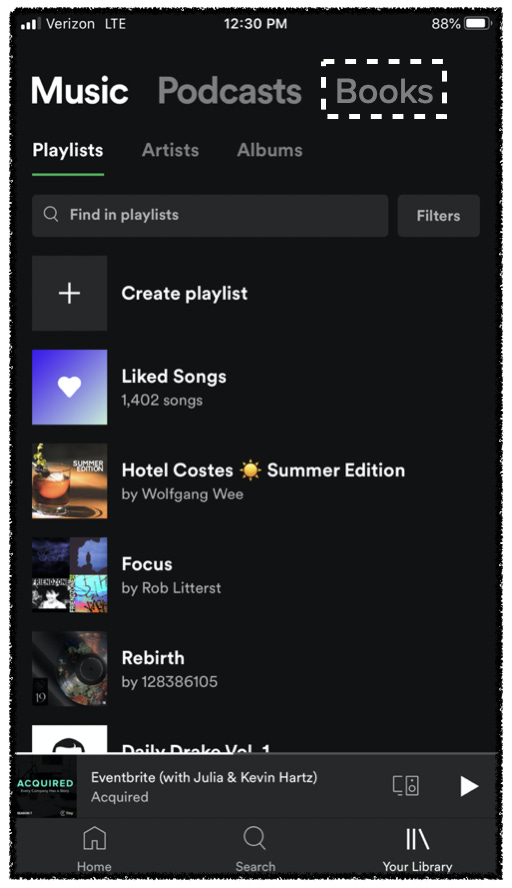SaaS Pricing is hard. PricingSaaS is your cheat code.
Monitor competitors, track real-time benchmarks, discover new strategies, and more.
Happy Sunday y’all!
The response from the last digest was positive, so we’re running it back this week! Coincidentally, all 3 topics center around bundling, with each bundle touching on music streaming. As music has become firmly rooted as table-stakes, ancillary products are playing a bigger role, leading to fascinating developments across the key players in music streaming.
If you enjoy this post, do me a favor and click the “like” button up top (the heart). That way I’ll know which posts are resonating most!
On to the digest.
Briefing 📋
Apple One: A Troubled Bundle : Earlier this month, news broke that Apple is building a bundled subscription tentatively named Apple One. Analysts have speculated this bundle for a long time, and now that it’s here, I’m bearish. Ultimately, I have two concerns:
The bundle doesn’t have a true lynchpin.
In the age of abundance, consumers aren’t willing to settle for entertainment services.
Audible Plus: The Move before the Move 📚: This week, Amazon released an all-you-can-eat edition of Audible (with a limited catalog) called Audible Plus. This follows their announcement that they’re launching podcasts on Amazon Music. I expect Amazon to bundle these two subscriptions, giving them a new axis for differentiation, and an audio super-app.
YouTube Music: A Freemium Tragedy 🎭: YouTube Premium is one of the more underrated bundles in entertainment, but YouTube Music’s free plan is unusable, which is holding them back.
Apple One: A Troubled Bundle
We’ve been hearing rumors about Apple’s services bundle for years, and finally have confirmation it’s coming. Here are details from Mark Gurman, who broke the story.
“A basic package will include Apple Music and Apple TV+, while a more expensive variation will have those two services and the Apple Arcade gaming service. The next tier will add Apple News+, followed by a pricier bundle with extra iCloud storage for files and photos.”
He goes on to note that Apple is also working on an at-home fitness app tentatively titled “Project Seymour” that will offer virtual fitness classes and be included in the highest bundle tier.
First and foremost, I agree wholeheartedly with John Gruber at Daring Fireball, who questioned the execution of the bundle in general. Specifically, that it’s not one bundle at all, but a sequence of tiered offerings with underwhelming discounts.
“To me the whole point of a bundle should be twofold: a greatly simplified offering (“Just buy Apple One and get it all”) at a very compelling price (“Even if you don’t think you care about, say, Arcade and News+, hey, you’re effectively getting them for free”.)”
However, my concerns go well beyond that.
Let’s hone in specifically on the highest tier, which includes: Apple Music, Apple TV+, Apple Arcade, Apple News+, iCloud Storage, and virtual fitness classes.
Broadly, this mix of products is diverse enough that it could strike the right balance between Superfans and Casualfans to make a successful bundle. However, I have two main concerns:
None of the products act as a true lynchpin.
In the age of abundance, consumers aren’t willing to settle on entertainment services.
First, a good bundle has a lynchpin - a product people really want. Going through this product list one by one, not one is a market leader in its respective space…
Apple Music trails Spotify in music streaming, Apple TV+ is still in its infancy, Apple Arcade faces endless competition in gaming, Apple News+ is a bundle in itself that competes with an abundance of information sources, and Project Seymour will be entering a market with strong, focused incumbents: Peloton and Nike.
That leaves Cloud Storage. According to internal documents, Apple will market the bundle to families, allowing access for up to 6 people within a given subscription. A family subscription would make the prices of the bundle far more compelling, and would also make Cloud Storage a novel lynchpin.
However, my second concern makes this optimistic outcome a challenge for me. I struggle to picture the “Apple Family” that uses Apple’s entertainment products exclusively in a world where there are so many options for content, including many that are better than Apple’s offerings.
When done right, bundles can help drive acquisition and retention. While I could see some current Apple customers finding the bundle appealing, I don’t expect Apple to capture much new market-share with the bundle as currently organized. Simply put, in a world with Netflix, Spotify, Fortnite, NYT, and Peloton, Apple’s bundle is complementary at best.
Peter Kafka put it perfectly in a tweet following the news:
Audible Plus: The Move before the Move 📚
On the other hand, Amazon, arguably the best bundler in the world, launched a new service called Audible Plus, providing unlimited access to a curated library of audio content including audiobooks, podcasts, and original productions.
This news comes a couple of weeks after Amazon announced they would make podcasts available in Amazon Music. Both announcements are interesting for the immediate future, but even more so when thinking about downstream implications.
Immediately, Amazon can drive new Audible subscriptions by offering a cheaper monthly option with unlimited access to a smaller library rather than the traditional monthly credit-based subscription. On the Amazon Music side, by offering podcasts, they’re moving in the direction of Spotify and the all-purpose audio app.
What’s most interesting to me, is the possibility that these two products will merge in the future. Thinking about audio content right now, there are 3 primary pillars: music, podcasts, and audiobooks.
When looking at these two announcements together, it’s easy to see a future where Amazon Music and Audible Plus are bundled together, giving Amazon a serious differentiator against their streaming competitors.
For what it’s worth, I expect this to happen sooner than later.
A couple of weeks ago, Spotify listed a job post for a Head of Audiobooks. Spotify’s current audiobook offering is limited and mainly composed of public domain novels, with chapters available as individual tracks. I imagine in the future there will be a tab for Audiobooks to the right of Podcasts in the library navigation bar.
While Apple does offer audiobooks in their Books app, it doesn’t seem like they have any intention of consolidating their apps any time soon.
By combining Audible Plus with Amazon Music, Amazon could get a leg up on both competitors and launch an audio super-app that provides unmatched value across the 3 pillars. Additionally, this would give them a way to stifle churn from the traditional Audible subscription, which gets expensive if you don’t use it regularly.
Further, this would strengthen their chances of overtaking Apple Music as number 2 in music streaming.
YouTube Music: A Freemium Tragedy 🎭
On the outside looking in on the top 3 in music streaming is YouTube. You may or may not be aware that YouTube Music exists, and I would argue the lack of interest in YouTube Music has a lot to do with their Freemium strategy. Simply put, the free version of YouTube Music is unusable.
The key differentiator between the free and premium version of the app is background play (the ability to continue using the app while doing other things on your phone), which mirrors their strategy with YouTube premium.
The thing is, this differentiator works for YouTube premium. Most users watch videos within the app rather than playing them in the background. With music, users are almost always using their streaming apps in the background. This means the free version of YouTube Music is at a big disadvantage to the competition, making it especially difficult to drive usage from potential subscribers.
This is unfortunate because YouTube is a seriously interesting wild card in the streaming wars. Their combination of music and video is something Spotify has dipped into recently with the launch of video podcasts.
The issue for YouTube is they aren’t a leader in music. If they’re going to take market share from the incumbents, people need to try their product and like it. Through this lens, having an unusable free plan is doing them a serious disservice. As it stands, I imagine most of YouTube Music’s Premium subscribers are getting there by way of YouTube upgrades.
The YouTube Premium bundle is a sneaky good deal. While YouTube Music Premium costs $9.99, right in line with Spotify and Apple Music, YouTube Premium, which includes ad-free viewing across all of YouTube, YouTube originals, and YouTube Music Premium, costs $11.99.
Allowing background play in the freemium version of YouTube Music and limiting their differentiation to ads (a la Spotify) would give YouTube a better chance of driving new subscribers to their Premium product through YouTube Music, and make them a stronger challenger in the music streaming wars.
Enjoying Good Better Best?
If you enjoyed this post, I’d love it if you hit the “like” button, that way I’ll know which posts are resonating the most!
If you have thoughts or feedback, I’d love to hear from you! You can find me on Twitter here.







